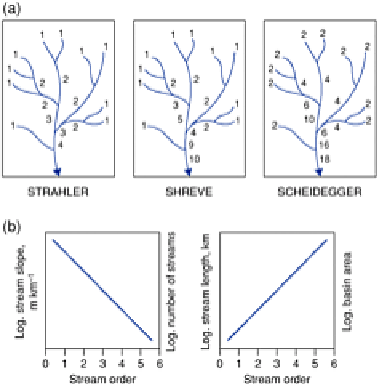Environmental Engineering Reference
In-Depth Information
Figure 14.13
(a) Schemes of stream ordering and (b) some
relationships between stream order and logarithmic values
for other network parameters, using Strahler's scheme.
Source: After Selby (1993).
and reflects catchment variables, channel network efficiency and maturity. In
hydrometeorological terms, higher drainage densities are associated with higher mean
annual precipitation, or strongly seasonal regimes, but correlations are far from simple.
High densities may also be found in semi-arid areas where lack of vegetation cover
compensates for lower rainfall. Drainage density increases during wet spells, as the
permanent network expands to incorporate intermittent channels. Geology influences
drainage density, which is inversely proportional to permeability, and is central in the
creation of
drainage pattern
, which strongly reflects the underlying geological structure
(Figure 14.14).
In two respects, network evolution is also time-dependent. The number and density of
lower-order streams are likely to increase on immature slopes before river connectivity
improves. This may be indicated by the
bifurcation ratio
of tributaries S of order
n
to the number of streams of the next higher order
n
+ 1. It falls
as the network becomes better integrated through channel capture and progressive
denudation of the land surface. The latter also represents an adjustment of drainage to the
underlying geological


